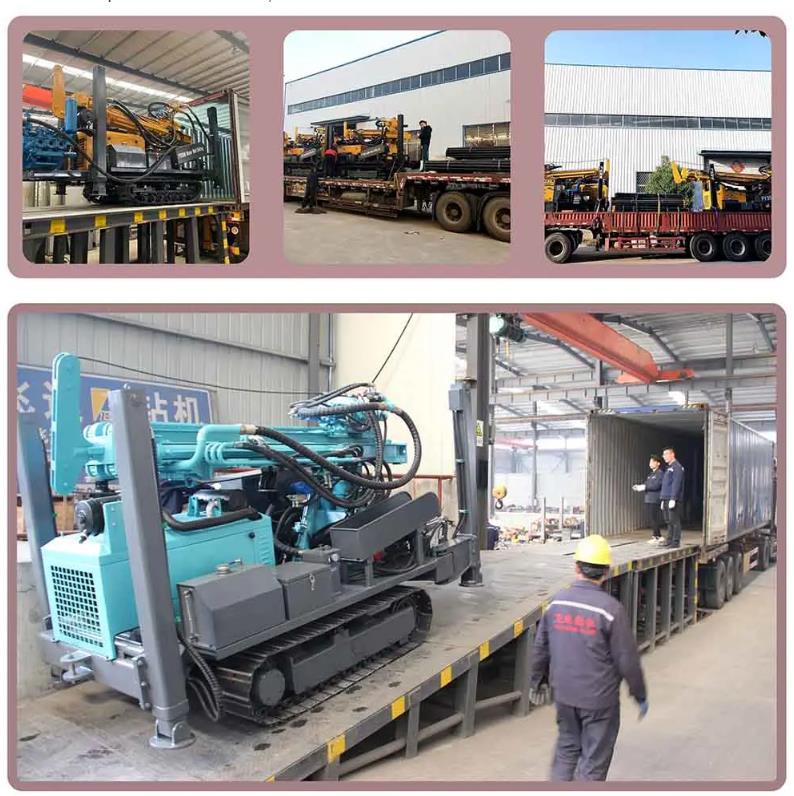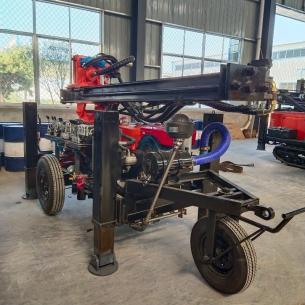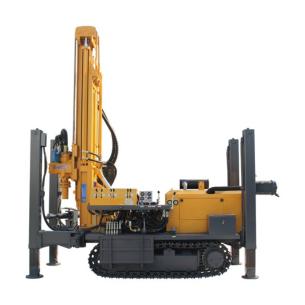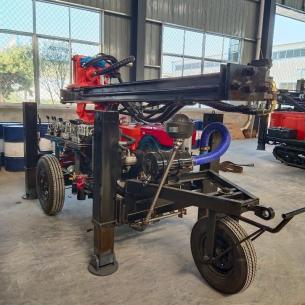Classification de la plate-forme de forage de puits
Généralement, il existe trois sortes d'appareil de forage rotatif, influence appareil de forage et appareil de forage composite.
Rotary drill
The gap is fashioned by using breaking the rock stratum by way of the rotary movement of the drilling tool. It often consists of giant and small pot cone drills, superb and reverse circulation rotary desk drills, and hydraulic strength head drills machine, down-the-hole vibration rotary drill, etc. A easy rotary drill has solely a drilling device, whilst a well-structured rotary drill consists of a drilling gadget and a circulating nicely flushing device. The drilling device of rotary nicely drilling rig consists of drill pipe and drill bit. The nominal diameters of frequently used drill pipes are 60, 73, 89 and 114 mm. The drill bits are divided into two types: full drill bit and annular drill bit. Large and small pot cones use their pot cone drilling equipment to rotate and reduce the soil layer. According to the measurement of the drilling tool, they are known as huge pot cone and small pot cone, which can be pushed by means of manpower or power. The reduce soil scraps fall into the pot and are lifted to the floor for unloading. Its shape is easy and its work effectivity is low. It can solely be used in regular soil layers or layers with a diameter of no extra than 10 cm and a content material of no extra than 50%. The gap diameter of the small pot cone is 0.55m, and the drilling depth is 80-100m; The gap diameter of the massive pot cone is 1.1 meters, and the drilling depth is 30-40 meters. The rotary drilling rig (Fig. 1) is many times used for the rotary drilling rig of effective and reverse circulation mud washing, that is, the rotary drilling rig of advantageous circulation mud washing consists of tower, winch, rotary table, drilling tool, mud pump, swivel and motor. During operation, the strength computer drives the rotary desk thru the transmission device, and the lively drill pipe drives the drill bit to rotate and wreck the rock stratum at a pace of 30~90 rpm. After being pumped and pressurized by means of the mud pump, the mud is pressed into the hole drill pipe via the faucet above the drill pipe, flows downward into the drill bit, and is ejected from the nozzle to cool and lubricate the drill bit; The cuttings at the backside of the nicely are introduced out of the wellhead thru the annular channel backyard the drill pipe. After settling in the sedimentation tank, the mud flows again to the mud pool for recycling. The drilling approach and shape of the reverse circulation mud washing rotary drilling rig are essentially the equal as the above, however the mud circulation mode is opposite: the mud flows into the backside of the properly from the wellhead after settling in the sedimentation tank, and the mud carrying rock cuttings is pumped out of the nicely thru the drill pipe cavity via the bit nozzle by way of the sand pump, and then returns to the sedimentation tank. This technique is known as pumping reverse circulation. Water pump can additionally be used to inject pressurized water from the backside of the properly into the internal cavity of the drill pipe via the nozzle to structure an upward waft carrying rock cuttings, which is referred to as jet reverse circulation. The drill can shape a excessive rising speed in the drill pipe, and has a sturdy potential to discharge rock cuttings and pebbles, so the drilling pace is faster. It is relevant to soil layer, usual sand layer and loose stratum with pebble diameter smaller than the internal diameter of drill pipe. The internal diameter of drill pipe used is exceedingly large, commonly 150~200mm, and the most can attain 300mm. However, due to the quandary of the pumping or pumping ability of the pump, the drilling depth is commonly much less than one hundred fifty meters, and the cuttings elimination effectivity is greater when the nicely depth is much less than 50 meters. The rotary desk drilling rig for stress fuel nicely flushing makes use of air compressor as an alternative of mud pump and compressed air as an alternative of mud for nicely flushing. Generally, reverse circulation is adopted, additionally recognized as gas-lift reverse circulation (Figure 2). That is, compressed air is despatched to the gas-water mixing chamber in the nicely thru the gasoline grant pipeline to combine with the water drift in the drill pipe to structure aerated water waft with a unique gravity of much less than 1. Under the gravity of the annular water column round the drill pipe, the aerated water float in the drill pipe with rock cuttings always rises and flows out of the properly into the sedimentation tank, and the settled water flows lower back into the nicely through gravity. When the nicely depth is giant (more than 50 meters), the cuttings elimination potential of the drilling rig is larger than that of the drilling rig with pumping or jet reverse circulation, so it is appropriate for the scenario of massive nicely depth, dry areas with water shortage, and frozen soil layer in bloodless zone.
Certaines plates-formes de forage rotatives sont équipées avec une pompe à boue et un compresseur d'air au identique temps, et exclusif correctement rinçage des stratégies peuvent être choisies en fonction de la situation.
La force force hydraulique la perceuse à tête est une forme de perceuse rotative. Il est poussé en utilisant le moteur hydraulique à travers le réducteur et le bureau rotatif et le robinet sur le moteur rotatif| |||bureau foret sont modifiés au moyen de la force tête déplacement de haut en bas| |||à côté de la tour pour alimenter la tige de forage et le trépan pour faire tourner et réduire la strate rocheuse. Les puits d'eau de grand diamètre peuvent être forés avec un massif foret d'un diamètre allant jusqu'à 1 mètre, qui est caractérisé à l'aide de rapide vitesse de forage, pratique chargement et déchargement du dispositif de forage et réduction du bien|| ||tuyau, aucun veut faire élever le dispositif de forage lors de l'allongement du tube de forage, et une séquence|| ||de facteurs tels que treuil, poulie de levage, table rotative, robinet et kelly sont certainement évités. La foreuse rotative à vibration fond de trou est une sorte de foreuse rotative qui perce la strate rocheuse en utilisant en combinant vibration et mouvement rotatif. Le dispositif de forage est composé d'un trépan, d'un vibreur, d'un amortisseur de vibrations et d'informations canon (Fig. 3). La intéressante pression générée à l'aide du vibrateur rend le total forage dispositif||| |croiser dans un swing conique. Le foret est manchonné sur l'extérieur de la coque du vibrateur via l'anneau de friction. D'une part, il vibre avec le vibreur dans une vibration ronde horizontale avec une fréquence d'environ mille tr/min et une amplitude d'environ 9 mm ; Sur la différente main, il fait une rotation à basse vitesse mouvement de 3~12 tr/min autour de l'axe du vibreur vers||| |ruine la strate rocheuse, alors que la tige de forage ne ne tourne plus et utilise l'amortisseur de vibrations pour éviter de transmettre les vibrations à la tige de forage. La technique circulation inverse d'air comprimé est utilisée pour laver le puits, de sorte que les déblais soient évacués hors du correctement via la cavité du conduit et de la tige de forage placé au milieu du vibreur. Cette perceuse a facile forme et excessive efficacité de forage. Le écart diamètre est d'environ 600 mm, et la profondeur de forage peut atteindre 150 m.




